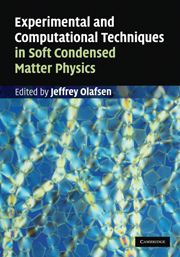Book contents
- Frontmatter
- Contents
- Contributors
- 1 Microscopy of soft materials
- 2 Computational methods to study jammed systems
- 3 Soft random solids: particulate gels, compressed emulsions, and hybrid materials
- 4 Langmuir monolayers
- 5 Computer modeling of granular rheology
- 6 Rheological and microrheological measurements of soft condensed matter
- 7 Particle-based measurement techniques for soft matter
- 8 Cellular automata models of granular flow
- 9 Photoelastic materials
- 10 Image acquisition and analysis in soft condensed matter
- 11 Structure and patterns in bacterial colonies
- Index
- References
2 - Computational methods to study jammed systems
Published online by Cambridge University Press: 05 July 2014
- Frontmatter
- Contents
- Contributors
- 1 Microscopy of soft materials
- 2 Computational methods to study jammed systems
- 3 Soft random solids: particulate gels, compressed emulsions, and hybrid materials
- 4 Langmuir monolayers
- 5 Computer modeling of granular rheology
- 6 Rheological and microrheological measurements of soft condensed matter
- 7 Particle-based measurement techniques for soft matter
- 8 Cellular automata models of granular flow
- 9 Photoelastic materials
- 10 Image acquisition and analysis in soft condensed matter
- 11 Structure and patterns in bacterial colonies
- Index
- References
Summary
Introduction
Jammed materials are ubiquitous in nature and share several defining characteristics. They are disordered, yet solid-like with a nonzero static shear modulus. Jammed systems typically exist in metastable states with structural and mechanical properties that depend on the procedure used to create them. There are a number of different routes to the jammed state, including compressing systems to densities near random close packing [1], lowering the applied shear stress below the yield stress [2], and quenching temperature below the glass transition for the material [3]. Examples of jammed and glassy particulate systems include dense colloidal suspensions [4], attractive glasses and gels [5], static packings of granular materials [6], and quiescent foams [7] and emulsions [8]. Due to space constraints, we will limit our discussion to athermal jammed systems in which thermal energy at room temperature is unable to induce local rearrangements of particles. We note though that there are deep connections [9] between athermal jammed systems and thermal, glassy systems [10]. An important open problem in the field of jammed materials is identifying universal features that are not sensitive to the particular path in parameter space taken to create them.
In this contribution, we will review the computational techniques used to generate athermal jammed systems and characterize their structural and mechanical properties. We will focus on frictionless model systems that interact via soft, pairwise, and purely repulsive potentials. (Computational studies of frictional granular materials will be the focus of Chapter 5.) The methods for generating jammed particle packings discussed here are quite general and can be employed to study both two- and three-dimensional systems; both monodisperse and polydisperse systems; a spectrum of particle shapes, including spheres, ellipsoids, and rods; and a variety of boundary conditions and applied stress.
- Type
- Chapter
- Information
- Publisher: Cambridge University PressPrint publication year: 2010
References
- 5
- Cited by



